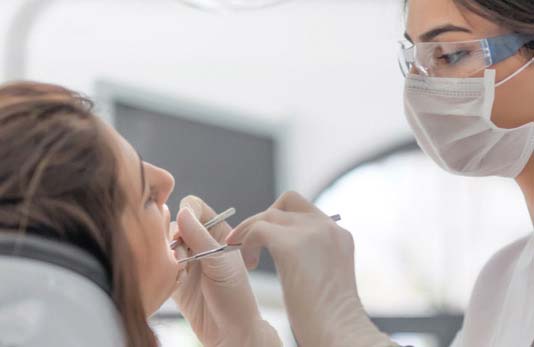How smoking affects your oral health
Learn the oral health consequences of smoking

The effects of smoking on your overall health are well known: a high risk of developing lung cancer, breathing problems, chronic obstructive pulmonary disease (COPD)… The list goes on. But you may not know that smoking can lead to oral health problems and make it more difficult to treat those problems, too.
How does smoking affect your oral health?
- Teeth wear down faster. Cigars, chewing tobacco, snuff and unprocessed tobacco leaves (used as cigar wrappers) contain tiny abrasive particles that erode tooth enamel over time.
- Fewer dental treatment options. The damage to your mouth from smoking includes reduced blood flow, increased bacteria and inflammation. These problems can make it more difficult to replace lost teeth. For example, implants and bridges might not be a treatment option because your surrounding teeth, gums and jawbone may have weakened from infection or decay and aren’t strong enough to support these procedures.
- Gum disease is harder to treat. Smoking affects your immune system’s ability to do its job, so if you’re a smoker being treated for gum disease, it will be harder to fight the problems associated with gum disease. Smoking also limits the growth of blood vessels, slowing the healing of gum tissue after oral surgery or from injury.
- More likely to get sick. Tobacco use reduces the body’s ability to fight infection, including in the mouth and gums. A simple infection can lead to something worse, like sepsis.
- Higher risk for other problems. Smokers are twice as likely to develop gum disease than non-smokers. Smokers also have a 10 times higher risk for developing oral cancer, and smoking is linked to increased risk for 12 other types of cancer.
What about vaping and e-cigarettes?
Vapes are an alternative product that work by heating a liquid that usually contains nicotine, flavoring and other chemicals until it produces an aerosol that users breath in.
Many young people believe that vaping is much safer than using cigarettes because e-cigarettes don’t contain tobacco. However, any substantial difference in safety is still up for debate as there aren’t many long-term studies. Young people who vape are also more likely to start smoking cigarettes in the future.
What about chewing tobacco?
Smokeless tobacco (also known as snuff or chewing tobacco) is known to cause cancers of the mouth, lip, tongue and pancreas. Like cigarettes, smokeless tobacco can lead to higher incidences of oral cancer. In fact, smokeless tobacco products, just like cigarettes, contain at least 28 cancer-causing chemicals.
A few of the other known health dangers include:
- Risk for cancer of the voice box, esophagus, colon and bladder because toxins in the juice created by chewing can be swallowed.
- Irritating your gums, which can lead to gum (periodontal) disease.
- Increased risk of tooth decay since sugar is often added to enhance the flavor of smokeless tobacco.
- Tooth sensitivity and enamel erosion due to sand and grit from smokeless tobacco wearing down teeth.
What can I do to protect my oral health?
If you’re a smoker, here are some essential steps to safeguard your oral health:
- Quit smoking. The most crucial step is to quit smoking altogether. Seek professional help or join cessation programs to quit successfully.
- Maintain oral hygiene. Maintain good oral hygiene by brushing your teeth twice a day and flossing daily. Regular dental check-ups are essential for early detection of any issues.
- Avoid smokeless tobacco. Smokeless tobacco products, such as snuff and chewing tobacco, can also harm your oral health.
- Stay hydrated. Dry mouth is common among smokers. Drink plenty of water to keep your mouth moist and prevent tooth decay.
- Limit alcohol and sugary drinks. Both alcohol and sugary beverages can exacerbate oral health problems. Consume them in moderation.
Remember, quitting smoking not only benefits your oral health but also improves your overall well-being.

Last updated August 7, 2024
Related articles:
The oral health information on this website is intended for educational purposes only. Always consult a licensed dentist or other qualified health care professional for any questions concerning your oral health.


